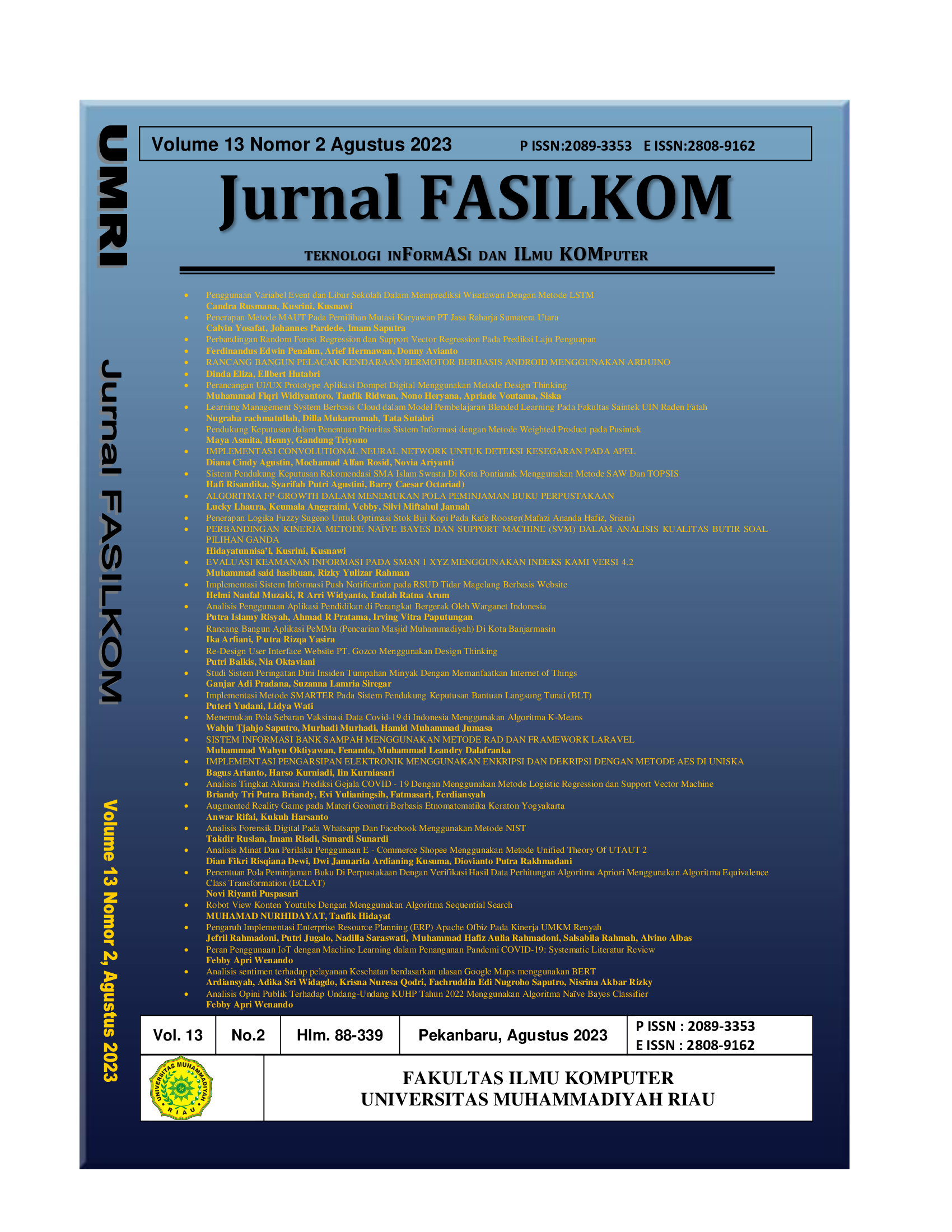Peran Penggunaan IoT dengan Machine Learning dalam Penanganan Pandemi COVID-19: Systematic Literatur Review
Abstract
Banyak penelitian yang dilakukan untuk membahas peyebaran, dampak serta akibat yang ditimbulkan oleh COVID-19 terhadap masyarakat pada pandemic terjadi. Pada saat dunia sedang terdampak penyakit COVID-19, penggunaan perangkat IoT terus meningkat setiap harinya. Ada beberapa hal yang bisa dilakukan untuk mengurangi kontak antarmanusia, termasuk pembatasan sosial. Machine Learning merupakan teknologi yang dapat digunakan dengan perangkat IoT. Pendekatan Machine Learning digunakan untuk memprediksi risiko yang terkait dengan COVID-19, untuk membuat prediksi dari data yang dikumpulkan oleh sensor hasil dai perangkat IoT. Artikel ini membahas terkait teknologi IoT yang memanfaat pendekatan machine learning untuk membantu penyebaran dan penangangan pendemi yang telah dilakukan oleh peneliti sebelumnya. Dari hasil banyak penelitian yang telah dilakukan tersebut, algoritma machine learning yang banyak digunakan pada perangkat IoT dengan perbandingan beberapa algoritma yang digunakan untuk data berskala menengah hingga kompleks, dengan tingkat akurasi tertinggi oleh RF (Random Forest) dengan akurasi mendekati 99%. daripada algoritma machine learning lainnya.
Downloads
References
[2] Loey, M., Manogaran, G., Hamed N. Taha, M., & Eldeen M. Khalifa, N. (2020). A hybrid deep transfer learning model with machine learning methods for face mask detection in the era of the COVID-19 pandemic. Measurement, 167, 108288 - 108288.
[3] Prakash, Kolla Bhanu dkk. 2020. International Journal of Emerging Trends in Engineering Research. Analysis, Prediction and Evaluation of COVID-19 Datasets using Machine Learning Algorithms, vol 8 (5), pp.2199-2204.
[4] Wenando, F.A. and Hayami, R., 2020, October. Bakaruddin, and AY Novermahakim,“Tweet Sentiment Analysis for 2019 Indonesia Presidential Election Results using Various Classification Algorithms,”. In Proceeding-1st Int. Conf. Inf. Technol. Adv. Mech. Electr. Eng. ICITAMEE (pp. 279-282)..
[5] Narin, Ali., Kaya, Ceren., & Pamuk, Ziynet. 2021. Pattern Analysis and Applications. Automatic detection of coronavirus disease (COVID‐19) using X‐ray images and deep convolutional neural networks¸vol 24, 1207-1220.
[6] Wenando, F.A., Hayami, R. and Anggrawan, A.J., 2020. Analisis Sentimen Pada Pemerintahan Terpilih Pada Pilpres 2019 Ditwitter Menggunakan Algoritme Naïvebayes. JURTEKSI (Jurnal Teknologi dan Sistem Informasi), 7(1), pp.101-106.
[7] Rahman, Tawsifur dkk. (2021). Computers in Biology and Medicine. Exploring the effect of image enhancement techniques on COVID-19 detection using chest X-ray images.
[8] Shen, Minzhe dkk. (2020). Journal of Pharmaceutical Analysis. Recent advances and perspectives of nucleic acid detection for coronavirus. 97-101.
[9] Prakash, Kolla Bhanu dkk. 2020. International Journal of Emerging Trends in Engineering Research. Analysis, Prediction and Evaluation of COVID-19 Datasets using Machine Learning Algorithms, vol 8 (5), 2199-2204.
[10] Panwar, Harsh dkk. 2020. Chaos, Solitons and Fractals. Application of deep learning for fast detection of COVID-19 in X-Rays using nCOVnet.
[11] Narin, Ali., Kaya, Ceren., & Pamuk, Ziynet. 2021. Pattern Analysis and Applications. Automatic detection of coronavirus disease (COVID‐19) using X‐ray images and deep convolutional neural networks¸vol 24, 1207-1220.
[12] Ozturk, Tulin dkk. 2020. Computers in Biology and Medicine. Automated detection of COVID-19 cases using deep neural networks with X-ray images.
[13] Khan, Asif Iqbal., Shah, Junaid Latief., & Bhat, Mohammad Mudasir. 2020. Computer Methods and Programs in Biomedicine. CoroNet: A deep neural network for detection and diagnosis of COVID-19 from chest x-ray images.
[14] Salman, Fatima M. dkk. 2020. International Journal of Academic Engineering Research (IJAER). COVID-19 Detection using Artificial Intelligence, vol 4(3), 18-25.
[15] Y. Rizki, R. Medikawati Taufiq, H. Mukhtar, F. Apri Wenando and J. Al Amien, "Comparison Between Faster R-CNN and CNN in Recognizing Weaving Patterns," 2020 International Conference on Informatics, Multimedia, Cyber and Information System (ICIMCIS), Jakarta, Indonesia, 2020, pp. 81-86, doi: 10.1109/ICIMCIS51567.2020.9354324.
[16] Cohen, Joseph Paul. 2020. Journal of Machine Learning for Biomedical Imaging. COVID-19 Image Data Collection: Prospective Predictions are the Future¸vol 2, 1-38.
[17] Wang, Linda & Lin, Zhong & Wong, Alexander. (2020). COVID-Net: a tailored deep convolutional neural network design for detection of COVID-19 cases from chest X-ray images. Scientific Reports. 10. 10.1038/s41598-020-76550-z.
[18] Apostolopoulos, Ioannis D & Mpesiana, Tzani A. (2020). Physical and Engineering Sciences in Medicine. Covid‐19: automatic detection from X‐ray images utilizing transfer learning with convolutional neural networks, vol. 43, 635-640.
[19] Chia, Po Ying dkk. (2020). Detection of air and surface contamination by SARS-CoV-2 in hospital rooms of infected patients¸ vol. 11, 2800.
[20] Ji, Tianxing dkk. (2020). Biosensors and Bioelectronics. Detection of COVID-19: A review of the current literature and future perspectives.
[21] Udugama, Buddhisha dkk. (2020). Diagnosing COVID-19: The Disease and Tools for Detection, vol.14, 3822-3835.
[22] Wenando, F. A., Adji, T. B., & Ardiyanto, I. (2017). Text classification to detect student level of understanding in prior knowledge activation process. Advanced Science Letters, 23(3), 2285-2287.
[23] Shahid, Farah., Zameer, Aneela., & Muneeb, Muhammad. (2020). Chaos, Solitons and Fractals. Predictions for COVID-19 with deep learning models of LSTM, GRU and Bi-LSTM.
[24] Loey, Mohamed dkk. 2020. Measurement. A hybrid deep transfer learning model with machine learning methods for face mask detection in the era of the COVID-19 pandemic.
[25] Loey, Mohamed dkk. (2020). Within the Lack of Chest COVID-19 X-ray Dataset: A Novel Detection Model Based on GAN and Deep Transfer Learning
Copyright (c) 2023 Febby Apri Wenando (Author)

This work is licensed under a Creative Commons Attribution-ShareAlike 4.0 International License.
Copyright Notice
An author who publishes in the Jurnal FASILKOM (teknologi inFormASi dan ILmu KOMputer) agrees to the following terms:
- Author retains the copyright and grants the journal the right of first publication of the work simultaneously licensed under the Creative Commons Attribution-ShareAlike 4.0 License that allows others to share the work with an acknowledgement of the work's authorship and initial publication in this journal
- Author is able to enter into separate, additional contractual arrangements for the non-exclusive distribution of the journal's published version of the work (e.g., post it to an institutional repository or publish it in a book) with the acknowledgement of its initial publication in this journal.
- Author is permitted and encouraged to post his/her work online (e.g., in institutional repositories or on their website) prior to and during the submission process, as it can lead to productive exchanges, as well as earlier and greater citation of the published work (See The Effect of Open Access).
Read more about the Creative Commons Attribution-ShareAlike 4.0 Licence here: https://creativecommons.org/licenses/by-sa/4.0/.
 Abstract views: 122 ,
Abstract views: 122 ,  PDF downloads: 121
PDF downloads: 121













_(1).png)


